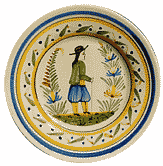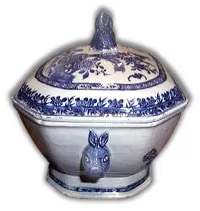The Chinese are credited with the invention of porcelain — a process of evolving from pottery to stoneware, and eventually to porcelain — that took approximately 1,000 years.
Thought to have appeared in the 4th century during the Jin Dynasty, true porcelain was crafted of clay, petunse (or China stone), and water, and fired at temperatures at or above 1250º Celsius.
Each piece of Chinese porcelain was created by a team of artisans, and depending upon the complexity of decoration, fired two or three times in the kiln.








- (Left to right): 1. Tang Dynasty earth spirit figure, c. 618-907 A.D.
- 2. Bat Trang incense burner, 16th century
- 3. A Qianlong Chinese Export tureen, circa 1760.
- 4. A painted pottery jar, circa 25-220.
Chinese porcelain falls into one of two classifications, either Imperial (official pieces made for the emperor or for his court for ritual use, decoration, or gifts to foreign dignitaries) or popular ware (utilitarian pieces for the table or for decoration in the home).
Imperial and popular ware are two categories of Chinese porcelain, each with distinct characteristics and historical significance:
Imperial Ware
Imperial ware refers to Chinese porcelain produced exclusively for the imperial court, primarily for the use of emperors, empresses, and the highest-ranking officials. These pieces were made with the utmost craftsmanship and were often considered the finest examples of Chinese porcelain. Characteristics of imperial ware include:
Exceptional Quality: Imperial ware is known for its exceptional quality in terms of materials, craftsmanship, and artistic decoration. Skilled artisans were commissioned to create these pieces, using the finest porcelain clay and glazes.
Exquisite Decoration: Imperial porcelain is often elaborately decorated with intricate designs, often featuring imperial symbols, dragons, phoenixes, and other motifs associated with the Chinese imperial family. The use of rich colors and intricate patterns is common.
Special Markings: Many pieces of imperial ware are marked with reign marks that indicate the specific emperor’s reign during which the piece was made. These marks can be used to date and authenticate imperial porcelain.
Limited Production: Imperial ware was produced in limited quantities, and only a select group of artisans had the privilege of creating these pieces. They were highly valued and treasured within the imperial court.
Popular Ware
Popular ware, on the other hand, refers to Chinese porcelain that was produced for the broader market and general population. These pieces were made in larger quantities and were more accessible to the common people. Characteristics of popular ware include:
Varied Quality: While some popular ware was of high quality and craftsmanship, much of it was more utilitarian and less ornate compared to imperial ware. This range in quality and decoration reflected the diverse tastes and budgets of the general public.
Simpler Decoration: Popular ware often featured simpler, everyday designs and motifs, making it more affordable and practical for daily use.
Diverse Forms: Popular ware included a wide range of forms and types, from functional items like bowls, plates, and cups to decorative pieces like vases and figurines.
Mass Production: Due to its intended broader market, popular ware was produced in larger quantities and was more readily available for purchase.
Imperial ware represents the highest level of Chinese porcelain production, reserved for the imperial court, and characterized by exceptional quality and intricate decoration.
Popular ware, on the other hand, encompasses a wider range of porcelain produced for everyday use and general consumption, with varying levels of craftsmanship and decoration. Both categories are important in understanding the rich history and culture of Chinese porcelain.
See also our Feature: All About Pottery & Ceramics
Chinese Dynasties
Whatever the Dynasty, be it Sung, Ming, or Qing, imperial porcelain is the most desirable to high-end and knowledgeable collectors.
The Qing Dynasty (1644-1911) represents both the apex and the decline of Chinese porcelain. Perfection of glaze and form were achieved during the Yong Zheng period (early Qing Dynasty, 1723-1735), and the height of technical perfection was realized in the Qianlong period (1735-1795).
This period saw a burst of breakthroughs (including improved clay and techniques); artistic creativity resulting in new mixtures and vibrancy of colors; some new vessel shapes (including more boxes); and the introduction of molded decorations on porcelain. Vases became reticulated, oversized, and more highly painted landscape scenes were in evidence.
This all coincided with a newfound artistic freedom in Jingdezhen, the city where the imperial factories were located from 1402 on, supplying porcelain to the courts for 500 years.
During Qianlong’s reign, everything became bigger, brighter and more impressive. Unfortunately, this era of improvement got out of hand. Qianlong became ill five years before the end of his reign, and Chinese porcelain underwent a gradual decline artistically, becoming more flamboyant and beginning to lose its real value.
This market has risen dramatically, and continues to do so. Chinese porcelain is a very mature area, similar to American furniture.
The audience doesn’t change much; it’s a very narrow, specialized field, and unlike most art markets, these people often don’t collect anything else. Imperial Chinese porcelain will always command an audience.
CHINESE PORCELAIN IDENTIFICATION
Shapes remained fairly constant over the millennia; the classic Chinese vase, bowl and meiping (plum blossom vase, introduced during the Sung Dynasty) continue to the present day. Still, shape and color can help to identify a piece with a particular period.
Certain colors are highly prized, and some design motifs are known to convey symbolic meaning (such as cranes representing immortality, or bats symbolizing happiness).
While some pieces are easily identifiable, the difficulty with identifying Chinese ceramics is that you must know everything that goes into making a particular piece right for its period.
Shape, color and design motif, glaze, weight, foot, reign mark — if there is one — all come into play. Other than clues from shape and color, you really have to handle the piece. The weight is an important clue to the educated collector.
As for fakes, the Chinese did make things in reverence of earlier emperors, but didn’t necessarily go out of their way to fake things. There aren’t a lot of pieces made to deceive… though a novice might unknowingly pass on a reproduction as an authentic piece.
WHERE TO FIND CHINESE PORCELAIN
It’s quite rare to find good Chinese porcelain in an antique store. Most collectors deal with the larger auction houses or with individual galleries in the United States, Europe, and Hong Kong. Though there is a large market for imperial porcelain in China, they don’t have the established galleries.
CONDITION
Collectors of Chinese ceramics are perfectionists and the most important thing is the condition. A technically perfect, beautifully glazed imperial piece in rough condition can fetch one tenth the value of the same piece in perfect condition.
Hairline cracks are considered as bad as chips, and restoration is definitely frowned upon (except by some collectors of the later export ware).
For references, we recommend:
- Chinese Ceramics: Porcelain of the Qing Dynasty 1644-1911), by Rose Kerr.
- Chinese Potter: A Practical History of Chinese Ceramics, by Margaret Medley.
- The Copeland Collection : Chinese and Japanese Ceramic Figures, by William Sargent.
Chinese Dynasties & Periods
| Shang Yin | 1766 – 1122 B.C. |
| Chou | 1122 – 249 B.C. |
| Ch’in | 221 – 206 B.C. |
| Han | B.C. 206 – 220 A.D. |
| Wei | 386 – 557 A.D. |
| Sui | 581 – 618 A.D. |
| T’ang | 618 – 906 A.D. |
| Five Dynasties | 907 – 960 A.D. |
| Sung | 960 – 1279 A.D. |
| Yung | 1280 – 1368 A.D. |
| Ming | 1368 – 1614 A.D. |
| Youg Lo | 1403 – 1424 A.D. |
| Hsuan Teh | 1426 – 1435 A.D. |
| Ch’eng Hua | 1465 – 1487 A.D. |
| Chia Ching | 1522 – 1566 A.D. |
| Wan Li | 1573 – 1620 A.D. |
| Ch’ing | 1644 – 1912 A.D. |
| Shun Chih | 1644 – 1661 A.D. |
| K’ang Hsi | 1662 – 1722 A.D. |
| Yung Cheng | 1723 – 1735 A.D. |
| Ch’ien Lung | 1736 – 1795 A.D. |
| Chia Ch’ing | 1796 – 1821 A.D. |
| Tao Kuang | 1821 – 1850 A.D. |
| Hsien Feng | 1851 – 1861 A.D. |
| Tung Chih | 1862 – 1873 A.D. |
| Kuang Hsu | 1874 – 1908 A.D. |
| Hsuan T’ung | 1909 – 1912 A.D. |
| Hung Hsien | 1916 – present |
Why Collect Asian Art?
Asian ceramics blend seamlessly with any style of interior. The English “treasure houses” were filled with Chinese export ceramics, Japanese lacquer, and other Orientalia.
French palaces held vast quantities of gilt-bronze mounted Chinese ceramics, which were often mounted after they had been damaged but were too valuable (even when broken) to be discarded.


The Dutch Delft, German Meissen (at left), and English Chelsea porcelain factories all imitated Chinese and Japanese patterns, which were prohibitively expensive at the time. Old Master paintings often depict elaborate still life tableaux, which frequently included Chinese blue and white porcelain amidst the subject matter.
The Asian concept of looking back to a classical time and a craft tradition that values the discipline of the art rather than the individual artist’s contribution is so antithetical to our Western views that it forms a fascinating counterpoint to look at our own art and culture in a different way.
Obviously, there are exceptions to every rule, but generally Asian art tends to be undervalued in relation to the amount of artistry involved in the fabrication of each piece.
For those interested in looking at art and antiques in a new way, the question isn’t “Why Asian art?” but rather, “Why not?”





